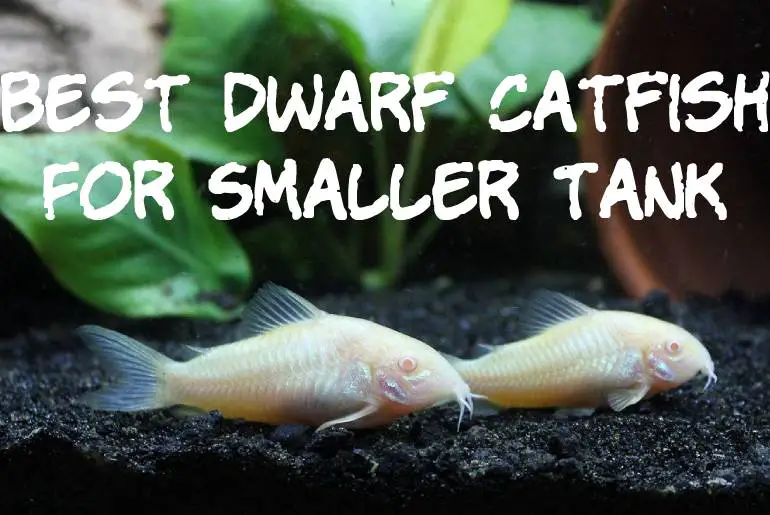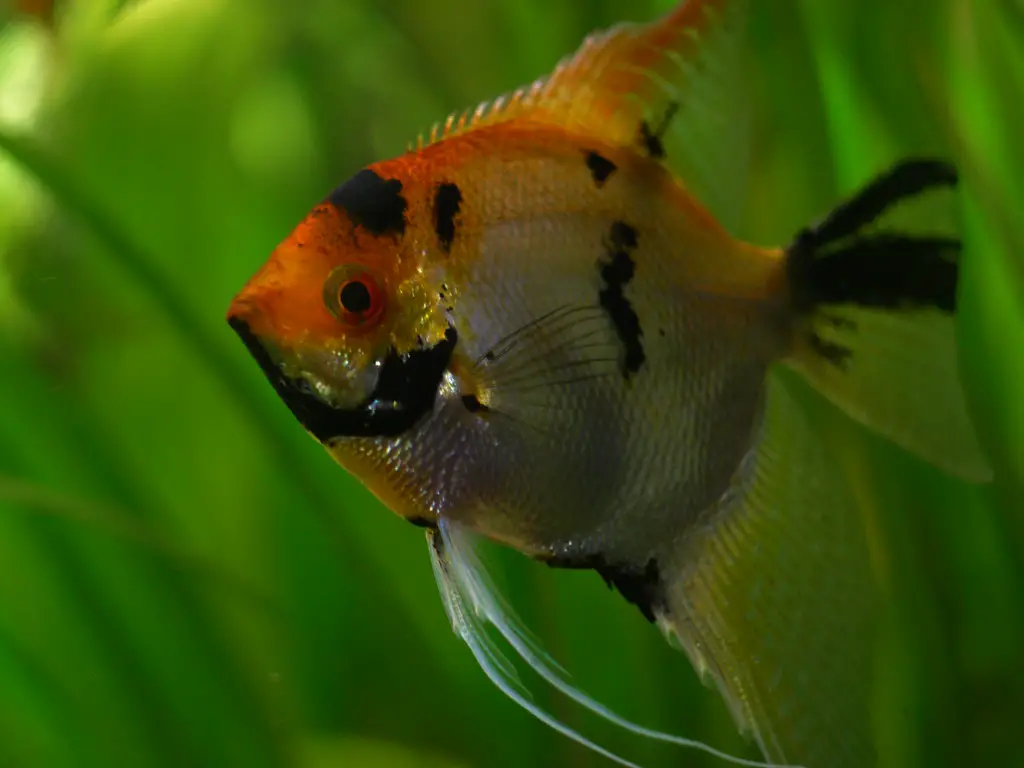People often come and ask me about the catfish they can keep in smaller tanks. I know they have the utter desire to raise a catfish and collect experience. But I often stumble around as there are very few catfish that would fit in a small tank. If you really want to keep a catfish, then there are a few. But which one of them is the best dwarf catfish?
Corydoras Catfish, Otocinclus Catfish, South American Bumblebee Catfish, Asian Stone Catfish, and Upside-Down Catfish are some of the best dwarf catfish you can keep in the smaller tank. Their small size can be a blessing to those who want to keep catfish in the tank.
However, there is always a catch to keep any of these fish in the tank. There is a definite list of things and appropriate tank size for you to keep these dwarf catfish.
I know I am making you more confused than you previously were. So, let me make it simple for you through the following article entirely dedicated to the best dwarf catfish.
5 Best Dwarf Catfish For Your Nano Tank Setup
Out of all the catfish, we often go for the ones that would be perfect for the tanks we have. I know for the fact that not everyone wants a tank big enough to keep in a room.
Most of the beginners want to keep a small fish that would adjust to the 20 to 30 gallons tank. Anyone who wants to start a big tank is most of the time a professional fish keeper or the one with enough experience to handle bigger fish like common Pleco.
Finding a smaller catfish is a really tough job. But once you know their name, you will find them around the corner all the time.
People are often unaware of the name but are familiar with the fish itself. When I was just a beginner, my aquarist friend had a clown Pleco in her tank.
I was quite familiar with the fish and its living habit. But I was completely in darkness about its type. I was so shocked when my friend told me it was a catfish.
That’s when I decided to do more research on catfish and came to know more about these wonderful fish.
Here I will let you in with the types of catfish that you can keep in a smaller tank. These catfish might be dwarf but trust me they are the best ones.
1. Corydoras Catfish

Care level: Easy
Size: 2.5 inches
Temperature range: 72 to 78 Degrees Fahrenheit
PH range: 7.0 to 7.8
Let’s begin with the most famous one from the group. These Corydoras catfish are like those popular kids in high school and have all the good qualities along with being every teacher’s favorite.
Both aquarists, either they are beginners or experienced, adore Corydoras catfish. Thanks to the multiple positive aspects of these fish.
These fish won’t even grow much bigger and will reach up to 2.5 inches max. Also, Corydoras are shoaling fish and will live in a group of 3 to 4 happily.
Hence, for this group of Corydoras catfish, a 10-gallons tank will be perfect. However, I suggest you go for at least 20 gallons of the tank as the growth of fish can be quite unpredictable.
With that said they are quite peaceful and full-time entertainers when they are kept in a tank. You even have options to choose from when it comes to Cory cats.
Bandit Corydoras, Bronze Corydoras, Panda Corydoras, Julii Corydoras, Pepper Corydoras, Skunk Corydoras, and Three stripe Corydoras are the types of Corydoras catfish you can choose from.
Additionally, Corydoras catfish are known for the high level of energy they have. They are also mentioned as workhorses for the way they clean the tank.
If you have a problem with keeping your tank clean, get these catfish. These bottom-dwellers will happily finish the uneaten food and help you maintain the water quality.
2. Otocinclus Catfish
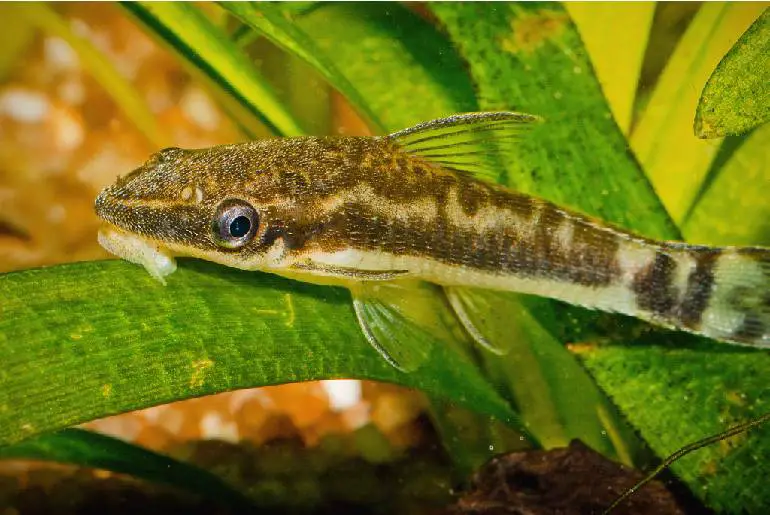
Care level: Easy
Size: 2 inches
Temperature range: 72 to 79 Degrees Fahrenheit
PH range: 6.8 to 7.5
Here to the one with too many names that I get confused about sometimes. Sometimes I think if fish could talk, Otocinclus would be like “you can call me anything you like Otos, Oto Catfish, Ottos, Dwarf Suckermouths, Dwarf Oto, Dwarf Ottos, Dwarf Suckers, Algae Scrapers, Otto Cats, I have too many friends who shorten my name to give me new nickname each day.”
Okay, jokes as well as imagination apart, let’s get serious now. Otocinclus are another one of the best dwarf catfish that are quite famous among aquarists.
There are so many features in Otocinclus that one can barely overlook this catfish. Apart from being a smaller catfish that can live in smaller tanks as 10-gallons, Otocinclus are great algae eaters.
Trust me, these beautiful catfish love algae more than you love your fish. They love to stay in the heavily planted tank and leaves with algae in it.
They will stay calm and peaceful while minding their own business eating algae in the aquarium. Just don’t let them feel lonely and uncomfortable.
You might like to read more about Can An Otocinclus Catfish Live Alone? Can I Just Keep One?
Your Otocinclus catfish can be quite sensitive and fragile if added to a new tank. It is better to get Otocinclus when you have a well-established tank.
Here is an article entirely dedicated to Do Otocinclus Catfish Eat Algae?
3. South American Bumblebee Catfish (Microglanis iheringi)
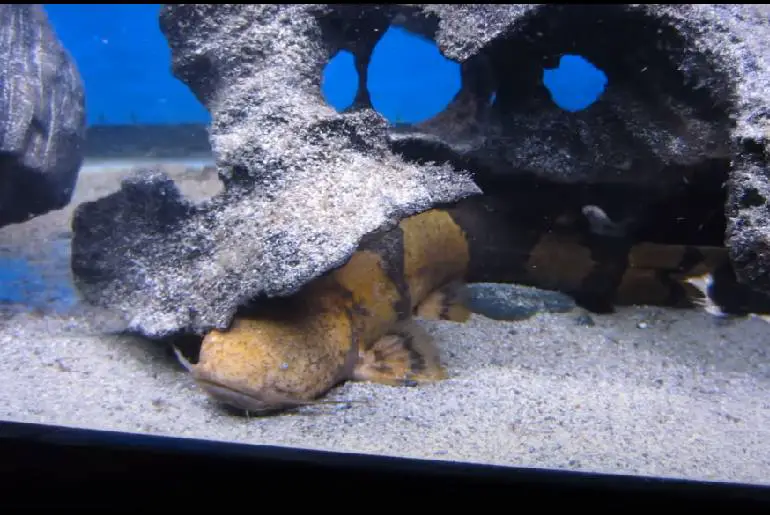
Image Credit: https://www.youtube.com/watch?v=xRXjL0Gu4Uc
Care level: Easy
Size: 2 inches
Temperature range: 70 to 77 Degrees Fahrenheit
PH range: 6.5 to 7.5
Now, coming to the 3rd one and something like a middle child of the list of best dwarf catfish, our one and only South American Bumblebee Catfish.
They might have a longer name but they barely grow over 2 inches. But you can never be too careful so it is better to go for 20 gallons tank rather than 10 gallons when it comes to our dead bumblebee.
This one really has a fun name and the name is connected to its beautiful features. The coloration similar to the bee with those strips is what makes these catfish top stand out among the tank equipment.
Talking about the equipment, your bumblebee is quite a shy one and asks for many hiding spots, remember that.
That being said, these catfish are hardy in nature hence, you can keep them in any standard freshwater tank.
Not blending into the background and yet searching for vegetation, driftwoods, rocks, and other hiding spots is quite a cute nature of this catfish, don’t you agree?
4. Upside-Down Catfish (Synodontis nigriventris)
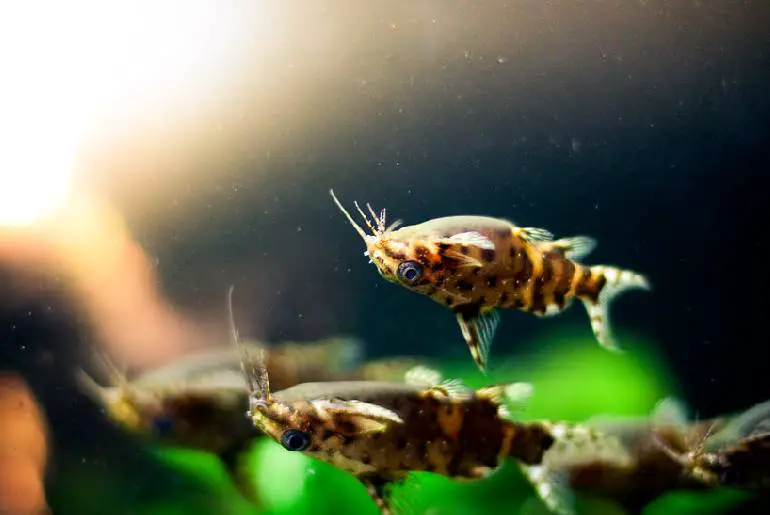
Care level: Easy
Size: 2 to 4 inches
Temperature range: 72 to 79 Degrees Fahrenheit
PH range: 6 to 7.5
Is it just me or the term upside down remind you of stranger things as well. Well, here we do not have the Demogorgon or eleven and this beautiful fish is definitely not one of the stranger things.
As unique as their name, this 2 and sometimes 4 inches catfish is a catch (not a prey catch just catch, you know what I mean). I need to stop cracking puns jokes and I know I am bad at it.
I may have told you there is nothing strange about this fish already yet there is one thing that I might have a miss.
What if I tell you your upside-down catfish can turn its head? Yes, you read it right. These catfish can indeed turn upside down hence their name.
Told you, the uniqueness of upside-down catfish is unmatchable. Don’t faint or get shocked when you see them grazing in the bottom of the tank upside down.
It is not scary as you are imagining right now, trust me. Rather they are too cute and the way they swim right up, I, most certainly, can watch them all day long.
If you are in love with Corydoras and want something similar, then here you have. These catfish are quite similar in size and appearance to your Cory catfish.
5. Asian Stone Catfish
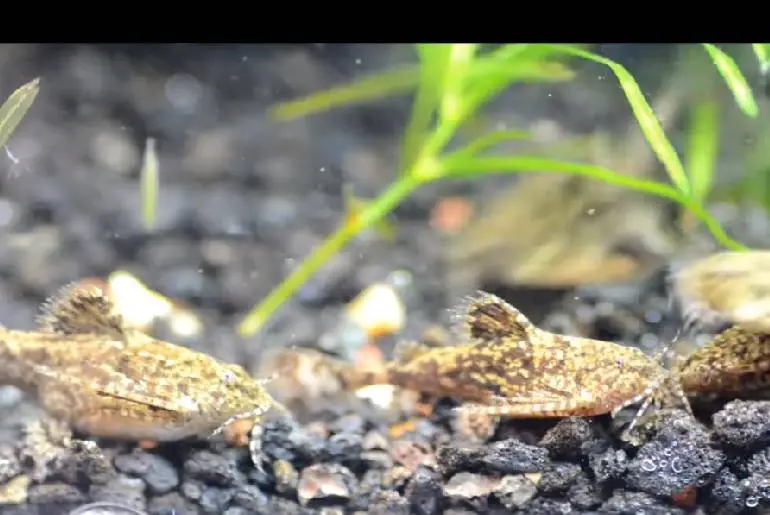
Image Credit: https://www.youtube.com/watch?v=qWmhHcYM1RE
Care level: Easy
Size: 1.3 inches
Temperature range: 64 to 75 Degrees Fahrenheit
PH range: 5.6 to 7.6
What else you want when you have a 1.3 inches long fish that will adjust in any tank you want. When I first searched for the best dwarf catfish, I missed this one and ended up not getting a chance to raise it.
I have very minimal experience when it comes to Asian stone catfish, unlike any other catfish. Don’t repeat the mistake I committed and give this one a try.
These dwarf catfish are so cute and beautiful, trust me you will love this one. Although they can be quite mellow and inactive, their standout looks are what make them so adorable.
Always relaxed with life and enjoying in their own world, this catfish lives the real goal of my life. Their coloration and patches make them mix so well with the stones that you will barely point them out.
Hence, living up to their name as Asian Stone catfish, this bundle of joy is what you should be getting ASAP.
How Many Catfish Can I Put In A 10-Gallon Tank?
The number of catfish you can keep in a 10-gallons tank depends on the type of catfish you have. If we are talking about bigger ones, then they will need tanks bigger than 100-gallons.
So, those ones will be out of the question. But if you are talking about these small catfish I just talked about then I will try to point out the numbers for you.
When it comes to Corydoras in the 10-gallons tank, you can go for 3 to 4 of them in the tank. While this changes when you go for Bumblebee catfish.
Bumblebee catfish is better for 20 gallons tank but you can still keep 1 of them in the 10-gallons tank. Coming to Otocinclus Catfish, the number is quite similar to that of Corydoras catfish.
I have also written an article on How many Otocinclus Catfish To Keep In A 10-Gallon Tank?
You can keep 3 Otocinclus Catfish in the 10-gallon tank and the same goes for the Asian stone catfish. Last but not the least, Upsidedown catfish will only adjust with 2 of them in the 10-gallons tank.
Things You Need For Your Best Dwarf Catfish In The Tank
You cannot overlook some of the necessities your catfish has even when it is undemanding and calm. Most beginners make the mistake of not paying enough attention to the bottom feeders and they end up killing them.
I know it can be hard to understand every need of your catfish but it is not that hard if you read the instructions carefully and follow them without a miss.
A simple change in the water quality and consistent fluctuation of temperature brings so many problems within the tank and to your fish health.
So not settle or compromise if you surely want your cute little catfish to live their whole lifespan happily.
Here are the things you need to have in the tank for your catfish to stay happy:
- A high branded aquarium Heater
- An aquarium Filter
- Sinking pellets or flake foods
- Brine shrimp, Mysis shrimp, and bloodworms (live or frozen)
- Plenty of hiding places
- Check water quality at least once a week
- Perform 25% of water change once every week or two
Frequently Asked Questions
I know the toll it takes to start a new hobby and the questions never end. That’s why to lessen your burden about fishkeeping catfish, I answered some of the FAQs people often ask.
Are Aquarium Catfish Aggressive?
Yes, catfish can be aggressive in the aquarium if they are not feeling comfortable. You see, these fish ask for very little and very easy to take care of.
These fish will often stay on the bottom of the tank grazing for algae. However, the problem starts when they meet someone who is similar in size and appearance.
These catfish can be lone wolves when it comes to living in the tank. They are the omega and won’t often ask for a pack.
But when someone intervenes, they will start acting like alpha and will become quite aggressive. Either keep them in a whole shoal or leave them alone.
They will start the war with the other one just to have fun and establish their superiority. If we are talking about smaller ones, they might behave rationally though.
Catfish like Pictus won’t act aggressively or even territorial. So, it is quite a dilemma to put all the catfish in the aggressive type.
The level of aggression and type of aggression depends on the type of catfish you have. Most of them can be quite peaceful while some can be scarily predators.
Do Catfish Keep The Tank Clean?
Most of the catfish are known for their bottom-dwelling nature and the way they scrape off all the waste as well as the algae from the tank.
Yes, your catfish can and are known to clean the tank. But do not depend on them for cleaning purposes.
They are fish, not a clean-up crew. These Catfish are definitely the workhorse when it comes to cleaning the tank.
They will eat up all the uneaten food and even devour the dead bodies present in the bottom. These bottom-dwellers often are the favorites of both beginners and experienced aquarists.
Some catfish are the world-famous algae eaters while others just act as the clean-up crew and clean anything in the tank.
You might like to learn more about 30 Best Algae Eaters For Freshwater Aquarium
Catfish like Chinese algae eater would lovingly and excitedly eat up the algae building up in the tank. Hence, you can keep them in the tank if you want to get rid of algae.
Here is an article on How To Get Rid Of Algae In Fish Tank Naturally?
How Many Cory Catfish Should Be Kept Together?
The number of Cory catfish depends on the type and size of the tank you have. There is a golden thumb rule for the number of Cory catfish you can keep in per gallon of water.
You can or should add 1 fish per gallon of water but this should only at first. Remember, you should not add multiple Cory catfish in the new aquarium at the same time.
For an average-sized tank, you can go for 5 to 8 Cory catfish altogether. But do not exceed this number or else the consequences are something you will not prefer.
Also, you need to make sure all the things are in the right place with optimum water quality for Cory catfish to live in.
Sometimes, simple mistakes like overcrowding the tank and failing to recognize the right tank size for them invites mental and physical stress for Cory catfish.
Conclusion
In conclusion. There are few catfish that will stay small and live happily in a 10-gallons tank. Even though there are options, people often tend to go for bigger catfish and make them live in a smaller tank. This will not only make those fish unhealthy but also make it unbearable for them to live. If you are into catfish and have a desire to keep one in the home aquarium but have a problem adjusting a bigger tank, then go for these four I have mentioned above. You won’t be disappointed and each of these catfish is equally entertaining and beautiful.
If you still have a query related to catfish and its types, write a comment down below and ask me anything you are confused about.
You will do great if you follow every basic instruction of fishkeeping. Don’t worry and stay alert.
Good Luck!!!
Happy Fishkeeping!!!

